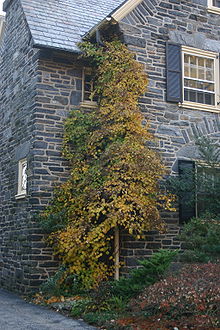Climbing hydrangea
| Climbing hydrangea | ||||||||||||
|---|---|---|---|---|---|---|---|---|---|---|---|---|

Flowering climbing hydrangea ( Hydrangea petiolaris ) |
||||||||||||
| Systematics | ||||||||||||
|
||||||||||||
| Scientific name | ||||||||||||
| Hydrangea petiolaris | ||||||||||||
| Siebold & Zucc. |
The climbing hydrangea ( Hydrangea petiolaris ), in the botanical literature Climbing hydrangea written is a plant type from the family of hydrangeaceae (Hydrangeaceae).
Occurrence
The climbing hydrangea is native to Japan , Korea and Taiwan . Today it can also be found as an ornamental plant in gardens in Europe and North America.
description
The climbing hydrangea can climb 6 to 7 meters, sometimes even 12 to 15 meters, and grow up to 5 meters wide with the help of sticky roots . Without climbing, it forms a hemispherical, deciduous bush up to 2 meters high. The growth rate is lower than that of ivy . The rounded to broadly ovate leaves are 5 to 10 centimeters long. The bark of older branches and trunks unrolls in a characteristic way in layers.
The plant is profuse; first flowers set in after about 5 to 8 years of standing. The inflorescences that appear in early summer are flat panicles 15 to 25 cm wide . Each inflorescence has small, 4 to 5-fold hermaphrodite flowers, some marginal, much larger, sterile , snow-white and mostly 4-fold flowers that reach about 3 cm wide. The flowers of the climbing hydrangea provide food for butterflies, bumblebees and bees. The fruits are designed as capsules .
While the classic climbing hydrangeas lose their leaves in autumn, there are now also newly bred varieties that are evergreen.
The number of chromosomes is 2n = 36.
Location and care
The climbing hydrangea prefers partially shaded to shady locations with humus, moist to wet, rather acidic soil that should neither be compacted nor calcareous. The pruning can be done in the spring and leads to the branching of long shoots.
Systematics
Hydrangea petiolaris is sometimes also considered a subspecies of the closely related species Hydrangea anomala .
literature
- Jost Fitschen: Woody flora (8th edition). Heidelberg, Quelle & Meyer, 1987. ISBN 3-494-01151-6
Web links
Individual evidence
- ↑ a b c Description of the species on Fassadengruen .de, accessed in February 2016
- ↑ List of native trees and shrubs from the LGLN Regional Directorates Lower Saxony, accessed in February 2016
- ^ Article in the Süddeutsche Zeitung. Süddeutsche Zeitung , September 15, 2014, accessed on August 25, 2020 .
- ^ Hydrangea petiolaris at Tropicos.org. In: IPCN Chromosome Reports . Missouri Botanical Garden, St. Louis

